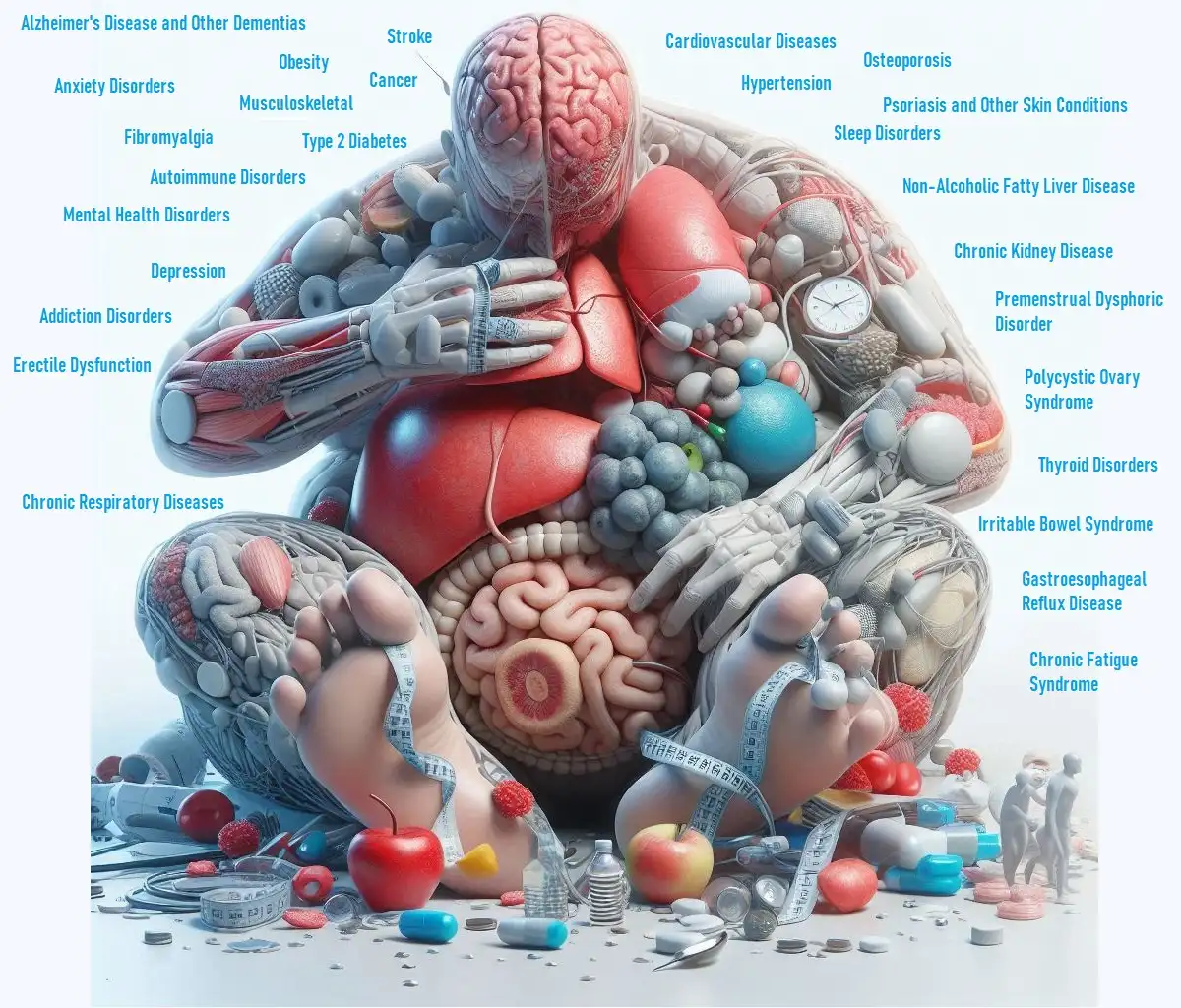
Non-Alcoholic Fatty Liver Disease (NAFLD) affects millions of people worldwide, and managing it involves a comprehensive approach. From the role of antioxidants to dietary adjustments and understanding environmental impacts, each factor plays a significant role in managing NAFLD. In this guide, we’ll break down these elements to help you take control of your liver health effectively.
Key Takeaways
- Antioxidants: Essential for reducing liver inflammation and oxidative stress.
- Metabolic Syndrome: NAFLD often overlaps with metabolic syndrome, complicating management.
- Environmental Toxins: Exposure to toxins can worsen NAFLD.
- Low-Carb Diet: Effective in managing NAFLD by reducing liver fat.
- Hyperlipidemia: High lipid levels are linked to NAFLD progression.
The Role of Antioxidants in NAFLD Management
What Are Antioxidants?
Antioxidants are compounds that neutralize harmful free radicals in the body. They help protect cells from damage, which is especially important for the liver, the body’s detoxification center.
How Antioxidants Help with NAFLD
- Reduce Oxidative Stress: NAFLD is associated with oxidative stress, where free radicals damage liver cells. Antioxidants can help counteract this damage.
- Decrease Inflammation: By reducing oxidative stress, antioxidants also lower inflammation, a key factor in NAFLD progression.
- Support Liver Function: Antioxidants like vitamin E and C, and compounds in fruits and vegetables, support overall liver health.
Best Sources of Antioxidants
- Fruits and Vegetables: Berries, oranges, and leafy greens are rich in antioxidants.
- Nuts and Seeds: Almonds and sunflower seeds provide significant antioxidant benefits.
- Green Tea: Contains catechins, which have antioxidant properties.
Practical Tips
- Incorporate Variety: Eat a diverse range of antioxidant-rich foods daily.
- Focus on Whole Foods: Prioritize fresh fruits, vegetables, and nuts over processed foods.
- Consider Supplements: Consult your healthcare provider about adding antioxidant supplements if needed.
NAFLD and Metabolic Syndrome: The Overlap
What Is Metabolic Syndrome?
Metabolic syndrome is a cluster of conditions including high blood pressure, high blood sugar, excess body fat around the waist, and abnormal cholesterol levels. It increases the risk of heart disease, stroke, and diabetes.
The Link Between NAFLD and Metabolic Syndrome
- Shared Risk Factors: Both conditions are linked by obesity, insulin resistance, and inflammation.
- Insulin Resistance: A common feature of metabolic syndrome that contributes to the development of NAFLD.
- Inflammation: Both NAFLD and metabolic syndrome involve chronic inflammation, which exacerbates liver damage.
Managing Both Conditions
- Healthy Eating: Focus on a balanced diet to manage blood sugar, cholesterol, and weight.
- Regular Exercise: Helps control blood sugar and insulin resistance, benefiting both conditions.
- Medical Monitoring: Regular check-ups to monitor and manage risk factors associated with metabolic syndrome and NAFLD.
Practical Tips
- Adopt a Mediterranean Diet: Rich in healthy fats, lean proteins, and whole grains, it helps manage both NAFLD and metabolic syndrome.
- Set Achievable Goals: Small, consistent lifestyle changes can significantly impact your health.
- Stay Informed: Regularly review your condition with your healthcare provider to adjust your management plan.
Impact of Environmental Toxins on NAFLD
How Toxins Affect the Liver
Environmental toxins, such as pollutants and chemicals, can exacerbate NAFLD by increasing oxidative stress and inflammation in the liver.
Common Environmental Toxins
- Air Pollution: Exposure to particulate matter and chemicals can worsen liver health.
- Chemicals in Food: Pesticides and additives may contribute to liver damage.
- Industrial Chemicals: Contact with substances like solvents and heavy metals can impact liver function.
Reducing Toxin Exposure
- Choose Organic: Opt for organic produce to minimize pesticide exposure.
- Improve Indoor Air Quality: Use air purifiers and avoid smoking indoors.
- Be Cautious with Chemicals: Limit exposure to household and industrial chemicals.
Practical Tips
- Wash Produce: Thoroughly wash fruits and vegetables to remove pesticide residues.
- Ventilate Your Home: Ensure good ventilation to reduce indoor air pollution.
- Select Safe Products: Choose environmentally friendly and non-toxic cleaning products.
Role of Low-Carb Diet in NAFLD Management
Why Low-Carb Diets Help
A low-carb diet reduces the intake of sugars and refined carbs, which helps decrease liver fat and improve insulin sensitivity.
Benefits of a Low-Carb Diet for NAFLD
- Reduces Liver Fat: Low-carb diets help decrease fat accumulation in the liver.
- Improves Insulin Sensitivity: Reducing carbohydrate intake can enhance the body’s ability to manage blood sugar.
- Decreases Inflammation: Lower carb consumption can help reduce inflammation, benefiting liver health.
Foods to Include
- Lean Proteins: Chicken, fish, and tofu are excellent choices.
- Non-Starchy Vegetables: Broccoli, spinach, and bell peppers are low in carbs and high in nutrients.
- Healthy Fats: Avocados, nuts, and olive oil support overall health.
Practical Tips
- Plan Your Meals: Prepare meals ahead of time to ensure you stick to your low-carb goals.
- Read Labels: Check for hidden sugars and carbs in packaged foods.
- Stay Hydrated: Drink plenty of water to support your metabolism and overall health.
NAFLD and Hyperlipidemia: Exploring the Link
What Is Hyperlipidemia?
Hyperlipidemia refers to elevated levels of lipids (fats) in the blood, including cholesterol and triglycerides. It is a common condition associated with NAFLD.
How Hyperlipidemia Impacts NAFLD
- Increases Liver Fat: High lipid levels contribute to fat buildup in the liver.
- Worsens Insulin Resistance: Elevated lipids can worsen insulin resistance, aggravating NAFLD.
- Promotes Inflammation: Hyperlipidemia can exacerbate inflammation, leading to more severe liver damage.
Managing Hyperlipidemia with NAFLD
- Dietary Adjustments: Focus on reducing saturated fats and increasing fiber intake.
- Medications: Statins and other lipid-lowering medications may be prescribed to manage lipid levels.
- Regular Monitoring: Keep track of lipid levels and liver function with your healthcare provider.
Practical Tips
- Eat Heart-Healthy Foods: Include foods rich in omega-3 fatty acids, such as fish and flaxseeds.
- Limit Alcohol: Excessive alcohol consumption can worsen hyperlipidemia and NAFLD.
- Exercise Regularly: Physical activity helps manage lipid levels and improve liver health.
Conclusion
Managing NAFLD involves a multifaceted approach, including antioxidants, dietary adjustments, understanding environmental impacts, and managing related conditions. By addressing each of these areas, you can take proactive steps towards better liver health. Always consult with healthcare professionals to tailor these strategies to your individual needs and ensure effective management of NAFLD.
For additional information, resources, and support, consider visiting NAFLD Research or Liver Foundation.








